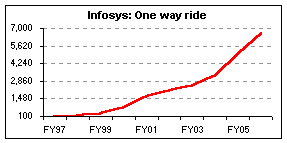P/E ratio: Look beyond it!
The P/E ratio is easily one of the most widely used valuation metric employed by the investors worldwide to arrive at an attractiveness of a stock. However, what the ratio numerically denotes is not necessarily the truth always and application of other valuation matrices could prove to be more useful. Let us see where this ratio fails and how other ratios takes its place.
We have heard a lot of people say that since companies like Tata Steel and Hindalco trade at lower P/E than say a company like Infosys, they are more attractively valued than the latter! Nothing could be further from the truth. It should be borne in mind that Tata Steel and Hindalco operate in cyclical industries where earnings peak and then fall and then scale another peak. Hence, for such companies, P/E will always look attractive during economic boom. However, investors should not fall into such a trap and instead should consider P/E based on the average earnings for the entire cycle rather than just a year’s earnings. Companies like Infosys on the other hand operate in growth industries and hence command better valuations than its cyclical counterparts. The charts given below where earnings are rebased to 100 help bring out the differences in earnings pattern.
 |  |
Just as low P/E does not necessarily mean that a stock is attractive, a high P/E stock cannot completely be ignored either. Quite a few times, it so happens that a quality company performs badly owing to some unforeseen circumstances or due to an unavoidable slowdown in industry. At such times, since the earnings suffer, P/E ratio could appear to be on the higher side. However, this does not mean that the stock has become less attractive; on the contrary, this could be a good opportunity to invest in a turnaround story at an attractive price.
Earlier, we saw how applying P/E to commodity companies could prove to be misleading during a cyclical peak and trough. In fact, one can go a step further and drop this valuation metric in favour of the more reliable P/BV (price to book value) for such stocks. Since profits for commodities largely depend upon the scale of capacities that they have, higher capacities would mean an ability to generate higher profits. Moreover, the more the capacities are financed by debt and internal accruals, the better it is, as this will result in a higher book value and thus a higher valuation.
Just as P/BV is a more reliable valuation tool for valuing commodity companies, there are a few other metrics like the PCF (price to cash flow) or P/S (price to sales) that lend themselves well to analysis of certain industries than the more widely used P/E. For e.g. in the auto industry, during times of high capex, where the company is working on a new platform or coming out with a completely new model, earnings might appear depressed and the stock might look less attractive on account of the higher resultant P/E. In such a case, PCF would give a better picture, as it will capture the capital investments that the company is undertaking and the benefits of which will accrue in the coming years.
Thus, depending upon the dynamics of the industry, an investor can come up with its own valuation metric to arrive at a correct picture regarding the attractiveness of the stock. We would also like to highlight that considering one valuation metric in isolation has its own risks and hence for cross checking and minimizing error purposes, stock valuation should be put to test against atleast 2 to 3 valuation tools.
It should be noted that depending upon the fundamentals (earnings track record, management, financial leverage, cash flows, return on capital etc), every company should command a certain P/E or a sector specific ratio. If one judiciously sticks to this pre-determined ratio and takes investment related decisions accordingly, then a lot of heartburn arising out of paying too much for a stock can be avoided. Please bear in mind that during times of boom, investors have a habit of becoming over optimistic and hence shifting the goalposts farther. A disciplined investor should not pay heed to this and should test the prevailing market price against his own pre-determined valuation metrics and then act accordingly. Please remember that all savvy investors earn their money this way; by adopting a disciplined investment approach rather than getting influenced by the mercurial behaviour of the market.
Source: EM
Additional Readings:- ‘FII investments in India will scale unprecedented heights in the long term’
- Return of Metals
- The right time to buy and sell
- Risks are rising in current market rally
- 10 stocks you may invest in
- India set to achieve 9.5% GDP growth: Montek
- Brokers bullish on Syngenta India, Punj Lloyd, TNPL
- Which sectors to bet on? Read ENAM's India Strategy report
- Be patient, have a long-term view in mkts: Uday Kotak
- Base metal prices seen rising: Swiss Asia Cap
- Sectors that gave incredible returns during June 05-06
- Is there a Trouble in paradise? Is India expensive?
- 'Global economy will slow down in '07'
- India Strategy (August 2006) - Enam
- Multiplex Sector - B&K
- Auto Sector - HSBC
- You only have to do a very few things right in your life so long as you don't do too many things wrong. - Warren Buffett